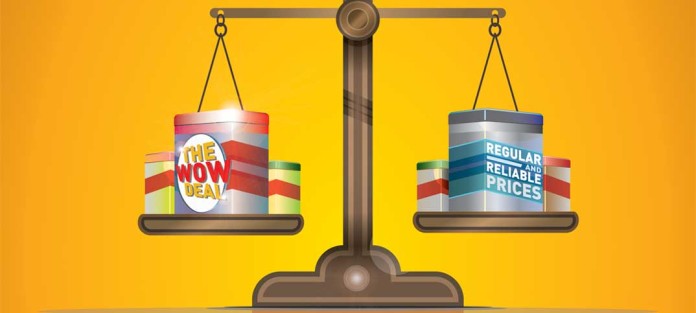Consistent low prices or regular ‘wow’ deals – what do today’s ultra-savvy retailers and caterers want? Elit Rowland investigates what makes an effective promotional strategy in wholesale.
1. Hit the spot: Find the right prices for products.
The challenge for wholesalers is to ensure that when they run a promotion, they are giving shoppers the ‘real deal’. A good starting point is speaking to customers as well as suppliers about the products and price points that will work.
Londis retailer Bintesh Amin says that the £1 price point works best for his customers. “£2 and £5 are also good,” he adds.
Capturing data on the prices and products that work well on promotion is critical when considering whether your promotional prices are right and where the value of electronic point-of-sale (EPoS) and data-crunching come into play.
John Kinney, retail director of Today’s Group, says, “If a retailer is in a symbol group, that group should be able to support the retailer to understand his pricing and margin by category and help flex his pricing accordingly. That’s where the real benefit of EPoS is – as a business support tool not just a scanning system.”
While the idea of hitting a price point that satisfies suppliers, customers and your own margins can seem impossible, industry experts believe there could be a ‘sweet spot’ that pleases everyone.
“We have undertaken work with some of our clients to analyse the area where volume increases start tapering off after certain price points are hit,” says Mike McGee. “Without looking at this, suppliers can be over-discounting with that extra 10p generating very little extra volume.









GETTING A GOOD DEAL OUT OF GOOD DEALS: THE ART OF PROMOTION MANAGEMENT
The impact of price promotions on sales has become ever more important to the extent that they often play a dominant role in profit generation and really drive consumer behaviour – which is exactly what they are designed to do, of course. However, the way promotions pump up sales volumes and have an impact on the sales of other lines puts great stress on the supply chain, especially on the forecasting and replenishment of fresh goods.
The challenge lies in incorporating promotion forecasting and replenishment into the supply chain planning processes; this can typically be overcome by following seven best practice tips.
1. Manage campaign information and forecast variables in the forecasting system;
2. Include logistical information such as required presentation levels as well as preferred delivery dates for initial quantities including stock for presentation purposes;
3. Let the system calculate the promotion forecast for consumer sales as well as the order forecast;
4. Review the forecasts and compare with previous campaigns - and modify them, if needed;
5. Collaborate with suppliers to ensure capacity and availability for fulfilment;
6. Execute to plan and demand;
7. Review success based on key metrics including operative supply chain KPIs and commercial KPIs
Best practice suggests that by incorporating highly granular data into a new breed of supply chain management technology, new insights can be achieved which ultimately help drive better planned and executed promotions that maximise sales without negatively affecting sales of other product lines or profit margins.
The more important promotions are for sales, the more important it is to include them in the forecasting and replenishment processes. Better promotion forecasting leads to better planned promotions using better data, which helps forecast subsequent campaigns more accurately.